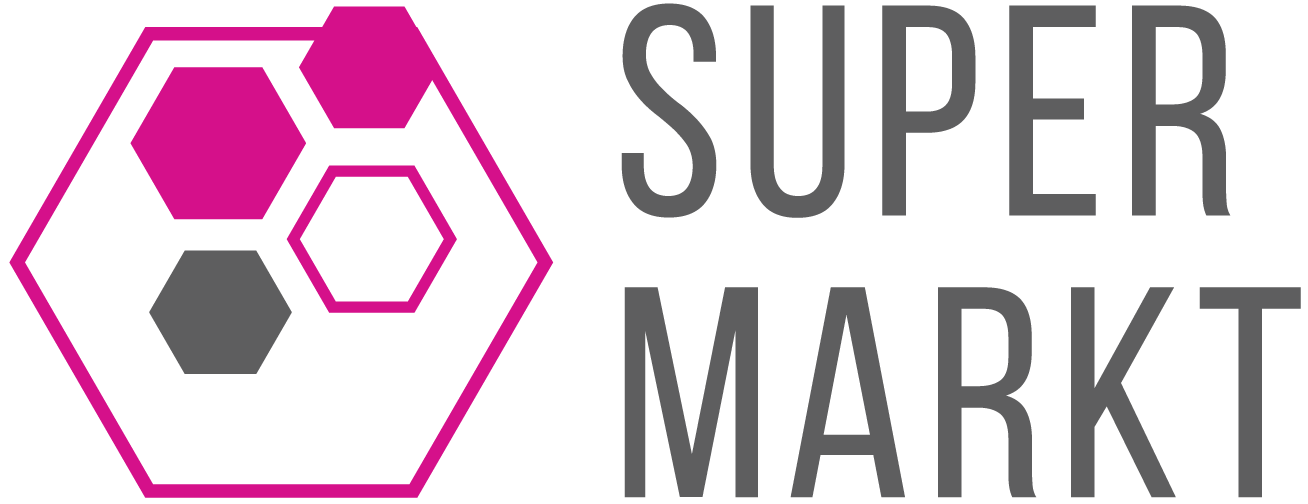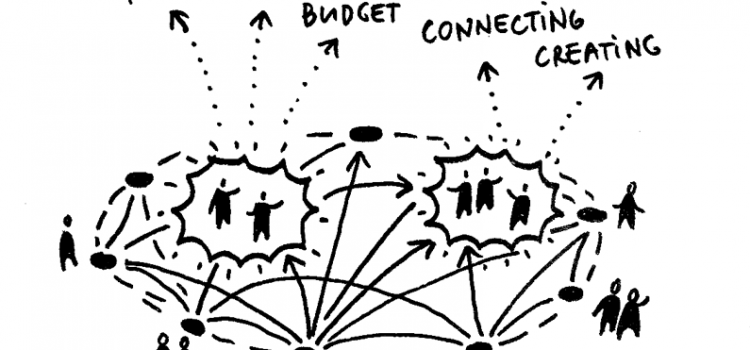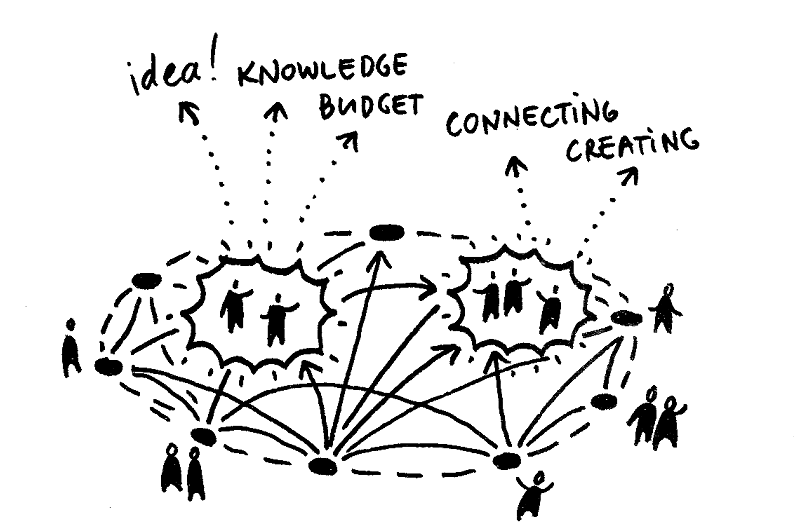On Wednesday, June 26th we hosted a Serendipity Lab. Jurriaan Pots, our colleague from Amsterdam, has written this personal account on the topic of Serendipity and why it matters to us at SUPERMARKT. The text is divided into two parts: the first part deals with our thoughts and expectations prior to the Serendipity Lab, the second part is a resumee of the key findings:
Some thoughts about the unexpected encounter: ’serendipity‘, the co-working space and creativity
by Jurriaan Pots
Next Wednesday SUPERMARKT is going to be examined and coached on its ’serendipitiousity‘: its power to produce unexpected encounters that lead to creative ideas. We invited Yulia Kryazheva & Sebastian Olma from the Serendipity Lab in Amsterdam to interview some regular users of SUPERMARKT and to think along about getting the most out of sharing a working space with different people.
In this blog post I am thinking out loud about what such a session might imply. What do we hope or expect to learn? And in which ways could serendipity possibly be improved? I am not an expert on this topic. And I am very new at SUPERMARKT (I joined the last week as a ‚Praktikant‘). So it will be very intuitively and I will raise more questions than I will answer. Serendipity can be understood and approached in many different ways. And as I understand, the coaching in serendipity is an experimental field. With this post we hope to provoke a discussion and start a process of mutual learning. Please react, add, correct, suggest and contextualize!
But first things first. As some of you might not be familiar with the term: what is serendipity exactly? Serendipity means a ‚happy accident‘ or ‚pleasant surprise‘; specifically, the accident of finding something good or useful while not specifically searching for it (source: Wikipedia). An American scientist, called Julius Comroe, described serendipity as “looking in a haystack for a needle and discovering the farmers daughter.”
Why is serendipity important for SUPERMARKT? What do we hope – expect to learn?
SUPERMARKT houses a variety of companies and freelance workers. Besides that it is a public space, as everyone can walk in and visit the café. Also many of the events are open for public. It is located at a main road with many cyclists and pedestrians and it has huge windows. The doors are always open. Under these circumstances there should be a big chance of spontaneous meetings. Besides, it looks as though a wide variety of people could meet at SUPERMARKT. Surely the internationally orientated community that is interested in the SUPERMARKT subjects. At itself this is a very diverse group, including people from an art/culture background, people interested in ICT, open culture and urban development. Possibly, SUPERMARKT could also be attractive for Gesundbrunnen neighbors who are not primarily interested in these subjects.
In an environment where so many different people come together, coincidence has to be a key word. There is not one person who has an overview and who draws lines between people who might influence each other. To a large extent, encounters have to happen spontaneously. More generally: like the initiators of Serendipity Lab, I believe that it is often wise to not have to rigid expectations about the future and be open to things that occur spontaneously. Coincidence and surprise are exciting and they can provide a lot of energy. They boosts the sort of creativity that a co-working space is looking for. It is the atmosphere where all kinds of ideas, projects and cooperations emerge. It might also give rise to ideas about the future of the organization, SUPERMARKT, itself – creatively, organizationally, financially.
I think that, with common sense, the SUPERMARKT team is already creating an atmosphere where happy coincidence can exist. What could external specialists possibly add to that? Firstly I think that a fresh view on the state of affairs is always good. Someone from outside observes all kinds of things that people inside the organization have since long taken for granted. Further it seems a good idea to interview users of the space and take time to let them straightforwardly tell what they think. Maybe in everyday life that just doesn’t happen so often. Lastly (but not least) it is very possible that Yulia and Sebastian know about all kinds of ’scientific findings‘ that could help: from psychology and sociology, but also about the relation between the space and social interaction.
So we want serendipity. But how to stimulate it? Here a very provisional and associative inventarisation of things that could improve the chance of happy coincidence:
– A combination of interesting people. They should have different backgrounds, but not too different (would a freelance journalist and a house painter stimulate each other professionally?). Also there should be good hosts: spiders in the social web. A good introduction can break the ice in the right away.
– People who are healthy and feel good. They are more creative, so also in cooperation more interesting things will evolve. This is of course quite an elaborate subject. It has to do with tension vs. relaxation, feeling appreciated, professional pride, etcetera. This is an interesting article about the subject, issued in the New York Times last winter: http://www.nytimes.com/2013/02/10/opinion/sunday/relax-youll-be-more-productive.html?pagewanted=all&_r=1&. Also interesting is the case of Ricardo Semler, a Brazilian industrialist who advocates giving all employees a lot of freedom and responsibilities. http://en.wikipedia.org/wiki/Ricardo_Semler
– Moreover, the well-being and creativity of people has a lot to do with the working space: with the furniture (sitting straight up, on sofas or standing?) the light, and sound. SUPERMARKT has some of background noise, from co-workers and the Brunnenstrasse. This is an interesting short article about that: http://www.theatlantic.com/health/archive/2012/06/study-of-the-day-why-crowded-coffee-shops-fire-up-your-creativity/258742/
– With the risk of being too spiritual: maybe people could also work on their personal attitude. If you want to give happy coincidence a chance, you should not be too goal oriented, and be willing to let your initial plans go once something else comes on your way.
We are very curious what the SUPERMARKT community and Yulia and Sebastian have to add to all this!
Serendipity Lab Part 2: What happened
Last week we organized a workshop day with Yulia Kryazheva and Sebastian Olma from Amsterdam. With the methods of their Serendipity Lab, they analyzed SUPERMARKT’s potential to attract unexpected encounters that lead to creativity. In the blog post Serendipity Lab: what to expect I was thinking out loud about the term serendipity and our expectations from the workshop. This is the follow-up of that post. I will report what surprising practices happened in and around SUPERMARKT that day, and tell something about our learnings and considerations. Again, I will raise more questions than I will answer (just like, as could be expected, the workshop did). And again we are very curious about your thoughts.
From the moment Yulia and Sebastian walked in to SUPERMARKT, on a Tuesday night, they took the attitude of curious reporters. They looked into every corner of the building and approached everyone around for a quick questioning. After this first encounter with the space they returned on Wednesday morning to sit down and speak more extensively with some regular SUPERMARKT visitors (with the kind help of Kate, Scott, Lubina, Stefan, Hans, Claudia and Susa!) These conversations took place in an informal setting in the cafe. We had lunch at an improvised long table in the middle of the space, and this table was converted into a workshop setting afterwards. In the afternoon we sat together there with Yulia, Sebastian, Ela, Zsolt, Katharina, Luise, Fritzi and me to talk over the results. Yulia and Sebastian presented their findings with the help of Yulia’s drawings on the flip over and pretty quickly an engaged conversation arose.
To start with, Yulia and Sebastian put a strong emphasis on the design of the space, and the influence that has on social interaction. They are interested in different zones in the space and passages and lines of movement, but also in the light and the sound. The SUPERMARKT space is quite undefined and raw: it has initially been designed as, indeed, a supermarket. And in the essential spatial set up not much changed. The space is open, and from one viewpoint not very efficient. This counts for the café, co-working space and workshop space, but even more for the huge basement and the supply platform in the back (what can you possibly do with those?). Regarding this openness, with the users of the space Yulia and Sebastian discovered an interesting duality. On the one hand they often experience this openness as stimulating and inspiring. On the other hand, it can also be somewhat overwhelming. To be creative, it could be that people sometimes need a little bit more protection and ‚coziness‘. Yulia and Sebastian associatively suggested different ’solutions‘ for the space, for example creating a landscape of platforms with different heights. The SUPERMARKT organization is now at a point that there is time and space to think about an eventual design of the space. We will discuss that topic extensively the upcoming months, of course together with our community.
Further Yulia and Sebastian brought up the fact that SUPERMARKT is the home base of a very strong community. Interviewees expressed that they are happy to have so many interesting people together in one neighborhood, while they previously had to criss-cross the city constantly. Yulia and Sebastian noted how strong the power of community, and also of community management, is. In the case of SUPERMARKT the community can be seen as the magical force of the space, and maybe even its reason for existence. Objectively, without knowing about the social structures, it might seem to be a weird idea to start such a venue in this neighborhood. In practice, however, it works very well.
Another topic of focus was the neighborhood. We spoke about the current changes of the Brunnenviertel and the much discussed question whether also here a process of gentrification is taking place. Yulia and Sebastian where intrigued by the potential of the Brunnenviertel – close as it is to the highly gentrified Prenzlauerberg and Mitte. They also noticed the power of the U8 – the lifeline of the city – which brings you to Alexanderplatz in a 10 minutes, and to further to Kreuzberg in 10 more. Based on all these benefits, and the huge possibilities of the space, Yulia and Sebastian had many ideas for optimizing the business model of SUPERMARKT and attract more visitors. Thereby we would get the most out of the space while developing new audiences and opportunities. It is, however, still a question if this is exactly where the SUPERMARKT should be heading towards. We are constantly struggling in finding the right balance between paid and unpaid labor, community events and conferences with a good budget. It is also a question of our own capacities. How much growth can SUPERMARKT possibly sustain with our current resources?
Regarding serendipity – I haven’t used the word for a while – I am wondering how it goes together with a more business-oriented approach. Would there be room for indeterminacy and unexpected turns in the business model of the space, or is the future entirely mapped out? In that case, the term serendipity would just be used to advertise the creative atmosphere of the space once everything is running.
In retrospect, we are glad about the fresh view, the professional guidance by Yulia & Sebastian and all the interesting ideas that were brought up. This was a great chance for us to reassess our own work and to take some time to think about our goals and challenges. However, we would have liked to focus a bit more on the concept of serendipity. What exactly are the conditions for this much desired creative symbiosis? Can you make a formula for serendipity? And how do you analyze if it is at work in a certain environment? In the end, some subjects I mentioned in my last blog (well being and working conditions vs. creativity, openness for unexpected encounters on a personal level) did not come up in our discussions. Of course, this also had to do with a lack of time.
It is clear that this workshop gave us a lot of food for thought, and that it came at exactly the right moment. We want to thank Yulia and Sebastian for their curiousity, energy and all their valuable contributions.
Illustration: Yulia Kryazheva


